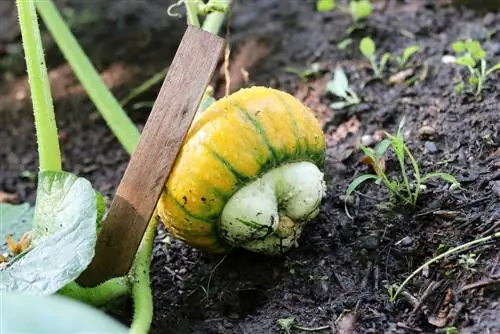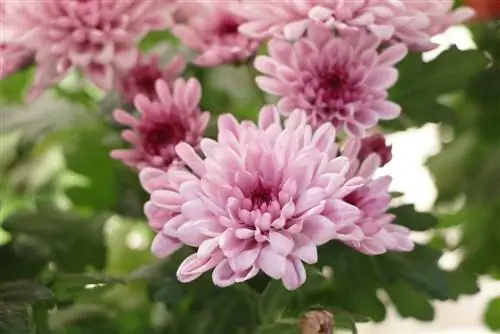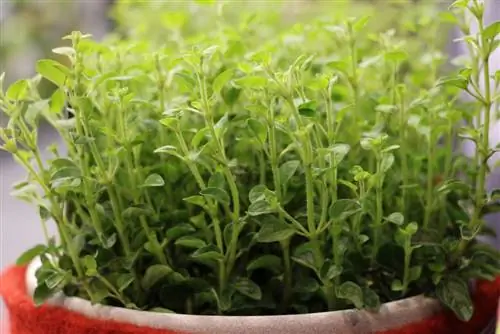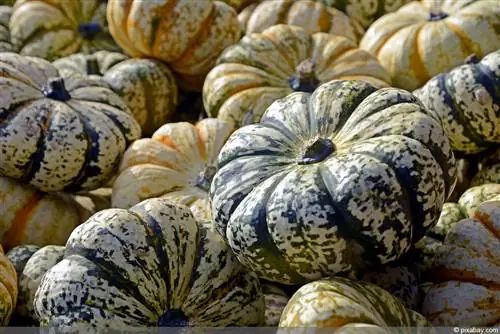- Author admin [email protected].
- Public 2023-12-17 03:39.
- Last modified 2025-06-01 06:48.
For autumnal and natural decorations or spooky decorations for Halloween, as a privacy screen or to provide shade - growing ornamental pumpkins can have numerous advantages if approached correctly. If you pay attention to the crucial requirements when sowing and give the plants the necessary care, you can enjoy the plants and fruits long before and after the harvest. With the right knowledge, cultivation is even possible without a green thumb.
Location
The sunnier and warmer, the better the ornamental pumpkin likes it at the location. A sheltered area near a wall or wall is favorable if it faces south. There is also a corner that is safe from too much wind and cold rain.
Substrate
Even if the fruits of the ornamental pumpkins are not suitable for consumption, the plants still need plenty of nutrients - and of course they have to find them in the substrate. A humus-rich soil based on compost or enriched with well-rotted compost is ideal. Vegetable soil is well suited, but also substrate for pot cultivation or normal garden soil. Since the ornamental pumpkin does not tolerate waterlogging, care should also be taken to ensure that the water drains sufficiently. It is usually sufficient to mix a little sand into the substrate.
Culture in a bucket
If the ornamental pumpkin is given a climbing aid, it can climb to astonishing heights and also grows relatively densely. On the balcony or terrace it provides ideal protection from unwanted looks, provides shade and also keeps the wind away. To do this, of course, it must be cultivated in a bucket. In order for cultivation to be successful in the very limited area, the following points should be taken into account:
- the bigger the better - prefer containers with a large volume
- Make sure there is enough light when covering the roof
- watering daily
- Ensure water drainage
- provide a climbing aid at least 1.5 meters high
Tip:
Because watering is the biggest maintenance effort when growing in a container, the soil should be covered with a thick layer of mulch. This reduces evaporation and reduces the need for watering.
Cultivation in beds
If you are more interested in the fruits of the ornamental pumpkin and only grow the plant for this purpose, you can do without a trellis and instead choose a vegetable bed as a location. However, enough space must be planned for this, because the plants spread rapidly and can easily take over the entire bed. At least one square meter should be planned for each decorative pumpkin and not too many plants should be planted. The bed must also be prepared accordingly. To do this, the soil is loosened on the surface and the weeds are thoroughly removed. It is recommended to enrich the soil with well-rotted compost at least one month before sowing or planting. Again, a layer of mulch is useful to protect against evaporation. Alternatively, foil can also be pulled over the soil. This prevents it from drying out too quickly and therefore reduces the amount of watering and water consumption. It also keeps the soil free of weeds and the fruits clean.
Pre-breeding
Since the ornamental pumpkin is a sun-loving plant that cannot tolerate frost, pre-germination from seeds makes sense. To do this, proceed as follows:
- Pots with a diameter of around 7 cm are filled with potting soil.
- One seed is used per pot.
- The substrate is well moistened, but should not be dripping wet.
- The cultivation containers are placed in a bright, warm place. For example, on a draft-free windowsill facing south or in a greenhouse. Ornamental pumpkins require a temperature between 20 and 24 °C to germinate.
- The substrate is kept moist throughout, even when the seeds have already begun to germinate.
- If the young plants have developed additional leaves in addition to the two cotyledons, they can be transferred to a bed or bucket. However, you should wait for the last frost to do this.
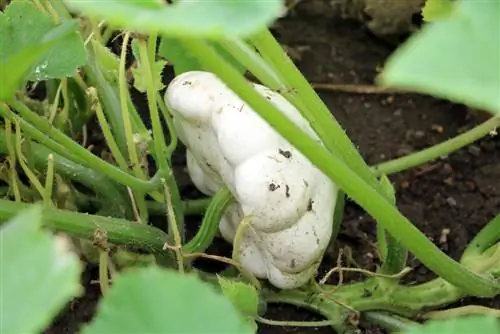
April and May are ideal times for pre-breeding, so the young ornamental pumpkins are ready to be planted out when frost is no longer expected. However, they are not too big.
Sowing
If you don't want to pre-germinate, you can also plant the seeds directly in the bucket or bed. However, there should be no more than four seeds and two permanent plants per pot. You can decide based on the space available in the bed. The ornamental pumpkin is sown in May or June, after the last frost. Here too, the substrate is kept moist. In addition, it is important to ensure a distance between the plants of at least 80, preferably 100 centimeters in all directions.
Tip:
It is more space-saving to offer climbing aids here too.
Pouring
The ornamental pumpkin is best treated with soft water, i.e. rain, stale tap or pond water without additives. Watering is carried out directly on the trunk and, if possible, not on the leaves, and often in smaller quantities. The substrate must be moist at all times but never wet, as this is not good for the ornamental pumpkin.
Fertilize
If the soil has been prepared with compost, further fertilization can usually be avoided when growing the ornamental pumpkin. If this is necessary or if the bed has not been prepared accordingly, compost, plant manure, vegetable fertilizer or horn shavings can be used during the flowering period. These are carefully and only lightly hooked into the surface or spread around the plant and distributed in the soil through the irrigation water.
Simply
Since the largest possible fruit is not important for the ornamental pumpkin, there is no need to pinch it out at all. If you need a few larger specimens for carvings or something else, proceed as follows:
- If fruiting bodies are already visible behind the flowers, the five strongest and largest pumpkins per plant are selected.
- The rest of the flowers are removed.
- Side shoots without flowers are pinched off or cut off directly on the main shoot.
Through this measure, the crop concentrates its forces on the remaining fruits, causing them to grow significantly more.
Harvest
To obtain decorative pumpkins, they should be placed on boards or foil without a climbing aid. This keeps them clean and free of unsightly stains as they grow. Harvest when the tops of the pumpkins are woody and begin to dry out and definitely before the first frost. If the decorative pumpkins have to endure frost, they begin to mold.
Conclusion
If you know the requirements of the plant, you will find the ornamental pumpkin an easy-to-cultivate plant with numerous possible uses. You can even grow it with children and it's great fun for them if they can then use the fruits of their labor for decoration or carve patterns and faces into them.
What you need to know about carving pumpkins
- The pumpkins should be as ripe as possible and not too small so that they can be processed easily.
- When selecting fruits, you should make sure that the surface of the peel is not damaged.
- Before processing, the pumpkins are stored for around 14 days so that they fully ripen and the skin becomes firm.
- Simple knives and spoons in different sizes are suitable as cutting tools.
- First the lid is cut out of the pumpkin. To do this, the knife is guided diagonally inwards so that the lid will hold later.
- When choosing a suitable lid shape, you should consider the shape of the pumpkin.
- There are no limits to your imagination, the shape can be cut round, square or jagged.
- The pulp is then scraped out with a spoon.
- The side wall should not be damaged and should remain at least 2 cm thick.
- Stencils can also be used for the faces. These can be transferred to the pumpkin with small needles or a pen.
- The face is carved out with a knife. Then all interfaces are smoothed with a cloth.
- A tea light or LCD light can be placed inside the pumpkin for illumination.
- The illuminated pumpkin looks great in window sills, in front of house entrances or fence walls.
Ornamental pumpkin - versatile crop
The pumpkin is not only a popular medicinal and garden fruit, but also delights many craft enthusiasts, especially in autumn. For example, it can be used as a flower vase when the pumpkin is cut out and cleaned. Then decorated with flowers and fruits such as rose hips, chestnuts or crab apples, the ornamental pumpkin becomes a successful autumn decoration. The inside of the pumpkin can also be lined with floral composition in advance. This way the flowers can easily be held in place. The flower-filled pumpkin vase is primarily suitable for table decoration indoors and outdoors or as a small gift.
Edible Pumpkins
The pulp of pumpkins can be used in a variety of dishes if they are edible fruits. If you are not sure, you can recognize edible pumpkins by tasting them. Inedible fruits contain bitter substances and taste accordingly. The bitter substances in the inedible fruits are harmful to he alth and should therefore not be consumed under any circumstances.

